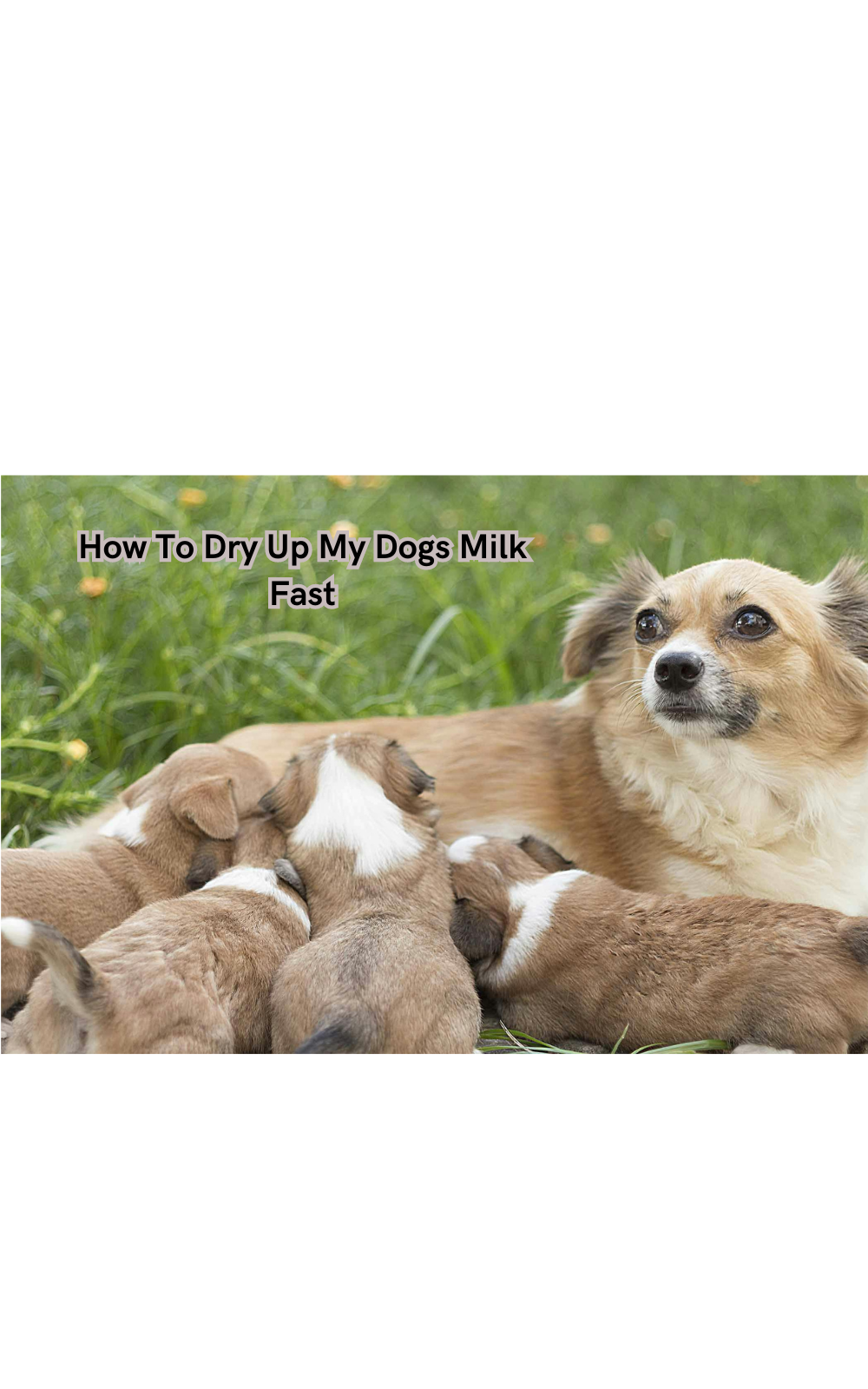How To Dry Up My Dogs Milk Fast
In this guide, we'll explore practical strategies such as adjusting her diet, limiting stimulation to her mammary glands, and providing supportive care. You can help your dog transition comfortably and smoothly with proper attention and patience.

If your dog has recently given birth and you're looking to dry up her milk supply quickly, there are several safe and effective methods to consider.
It's important to approach this process carefully and consider your dog's health and comfort. Following a few simple steps, you can help expedite the drying-up process without causing undue stress or discomfort to your furry friend.
In this guide, we'll explore practical strategies such as adjusting her diet, limiting stimulation to her mammary glands, and providing supportive care. You can help your dog transition comfortably and smoothly with proper attention and patience.
Why Need to Dry Up Dogs Milk
There are a few reasons why a dog owner may need to dry up their dog's milk supply. One common situation is when the puppies have been weaned and no longer need the mother's milk. Another reason could be if the mother is producing too much milk, which can lead to discomfort or potential health issues for both her and the puppies.
Dog mother's milk supply is also typically more than what the puppies need, so drying it up can help prevent any excess milk from going to waste. Reducing the mother's milk supply can also help prevent mastitis, a painful inflammation of the mammary glands.
Additionally, drying up milk quickly can help the mother's body recover more quickly and return to its normal state.
A female dog is typically able to produce milk for up to two months after giving birth, so it may be necessary to expedite the drying-up process if the puppies are already weaned. The weaning process can take anywhere from four to six weeks, so it's important to monitor your dog's milk supply closely during this time.
What Should I Do Before Starting the Process
Before you begin the process of drying up your dog's milk supply, it's important to consult with your veterinarian. They can provide you with professional advice and guidance tailored to your specific situation. They can also assess your dog's overall health and ensure that she is ready for the process.
In addition, it's crucial to make sure that any puppies have been fully weaned before starting the drying-up process. This will prevent them from trying to nurse and stimulating the mother's milk supply.
It's also recommended to have an appropriate supportive care plan in place, such as providing extra comfort and nutrition for the mother during this transition period. A dog's milk production is closely related to her diet, so it's important to make any necessary adjustments as recommended by your veterinarian.
How To Dry Up My Dogs Milk Fast- Different Strategies
Once you have consulted with your veterinarian and taken the necessary precautions, how to decrease milk production in dogs depends on the individual dog and her specific needs.
If a dog's milk dry-up is necessary, it's important to do so gradually and with the mother's health in mind. A female dog's body will naturally decrease milk production over time, but there are steps you can take to expedite this process.
Here are some safe and effective methods to help dry up your dog's milk supply quickly:
Managing Canine Diet:
Adjusting your dog's diet is an important step in reducing milk supply. Mother dog milk production is closely tied to her diet, so it's important to make any necessary changes under the guidance of your veterinarian.
Solid food should be gradually introduced to the puppies before starting the drying-up process. To stop milk by withholding food, it's recommended to decrease the mother's food intake gradually over a period of 7-10 days.
Puppy food can also be given to the mother in small amounts, as it is designed to provide adequate nutrition while reducing milk production.
Additionally, increasing the amount of water your dog drinks can help flush out her system and decrease milk production. However, ensure proper hydration and don't let her drink too much water as it can lead to other health issues.
Switching To Adult Food:
If your dog is currently on a puppy diet, switching to adult food can also help decrease milk supply over time.
This should be done gradually and with the guidance of your veterinarian to ensure that the mother receives adequate nutrition during this transition.
Food intake can also be reduced gradually to help decrease milk production. To stop milk production in dogs, it's important to only make these dietary changes under the guidance of a professional.
Limiting Stimulation To Mammary Glands:
During the weaning process, limiting any stimulation to the mother's mammary glands is important. This includes preventing puppies from trying to nurse and avoiding contact or play that may cause unintentional stimulation.
If your dog has a large litter, separating them into smaller groups during this time may be helpful to reduce stimulation and prevent any potential discomfort for the mother. It stimulates milk production, so minimizing any activities that may trigger this response is important.
Applying Cold Packs:
Cold packs can also be applied to the mammary glands to help decrease milk production. This should be done cautiously and only for short periods, as prolonged exposure to cold temperatures can cause discomfort or damage the sensitive area.
Milk to dry up and decrease production. Puppies begin to nurse less frequently when they realize the milk will no longer be available, and this gradual decrease can help the mother's body naturally adjust.
Medical Intervention:
Sometimes, a veterinarian may prescribe medication or recommend hormonal injections to help decrease milk production. These should only be used under professional guidance and supervision, as they can have potential side effects for the mother.
Producing milk also releases hormones that can help the mother's uterus return to its normal size after giving birth, so it's important to consider this before opting for medical intervention.
Proper care and precautions allow the drying-up process to be done effectively and safely. Consulting with a veterinarian and closely monitoring your dog's milk supply are crucial steps in ensuring her health and comfort during this transition period.
Home Remedies To Help Dry Up Dog's Milk Supply
Along with the abovementioned strategies, some home remedies may help decrease milk production in mother dogs. These include:
- Sage tea: Drinking sage tea may help reduce milk supply in nursing mothers.
- Parsley leaves: Chewing on parsley leaves or adding them to a dog's food can also help decrease milk production.
- Peppermint oil: Some sources suggest that applying peppermint oil to the mammary glands can help dry the milk supply. However, this should be done with caution and only under professional guidance.
- Cabbage leaves: Placing cold cabbage leaves on the mother's breasts have been known to decrease milk supply due to their anti-inflammatory properties. Again, this should be done with caution and only for short periods.
It's important to note that these home remedies have not been scientifically proven and should always be used in consultation with a veterinarian. They may not work for all dogs or could have adverse effects, so seeking professional advice before trying them is crucial.
Preventing Future Lactation
To prevent future lactation in dogs, spaying the mother after her litter has been weaned is important. Spaying not only helps prevent future pregnancies and unwanted litter, but it also eliminates the hormonal changes that trigger milk production.
If your dog is not going to have another litter, spaying her can help avoid going through the drying-up process again. It's best to consult a veterinarian to determine the appropriate time for spaying and ensure your dog is healthy enough for the surgery.
Breast milk production can also be disrupted by spaying while the mother is still producing milk, so it's important to wait until after weaning is complete before scheduling the surgery.
Another way is by controlling breed hormones, milk can be prevented. This involves putting your dog on birth control medication or hormone therapy to help regulate her reproductive cycle and prevent milk production.
However, this should only be done under professional guidance and supervision as these methods may have potential side effects on the mother's health.
FAQs
What do I do if my dog is producing too much milk?
If your dog is producing too much milk and causing discomfort or other health issues, consult a veterinarian. They may prescribe medication or recommend strategies to help decrease milk production safely. It's important not to try home remedies without professional guidance as they may be ineffective or could potentially harm the mother.
Does ice packs help dry up breast milk?
Applying cold packs to the mammary glands can help decrease milk production, but it should be done cautiously and only for short periods. Prolonged exposure to cold temperatures can cause discomfort or damage the sensitive area.
Do dogs naturally stop producing milk?
Yes, dogs will naturally stop producing milk once their puppies have been weaned. This process can be aided by limiting mammary glands' stimulation and gradually making dietary changes. However, in some cases, medical intervention may be needed to help decrease milk production faster.
Conclusion
In conclusion, drying up a dog's milk supply demands patience, empathy, and careful management to safeguard the health and well-being of both the mother and her puppies.
Reducing the mother's food intake, controlling her water consumption, and providing a tranquil environment are key strategies in slowing down milk production. Additionally, gentle massage and cold compresses can offer comfort and aid in the natural decline of milk production.
It's crucial to seek professional veterinary guidance throughout this process to ensure the mother dog's physical and emotional needs are met while avoiding potential complications.
By approaching the drying-up process with compassion and expert guidance, you can support your dog through this transition while promoting her long-term health and comfort.
